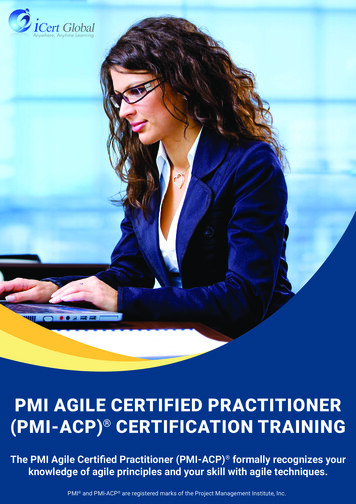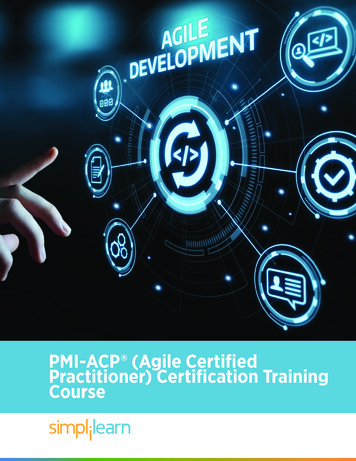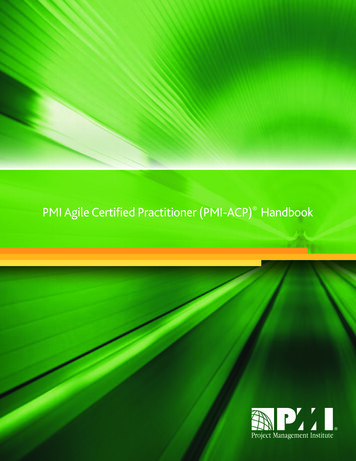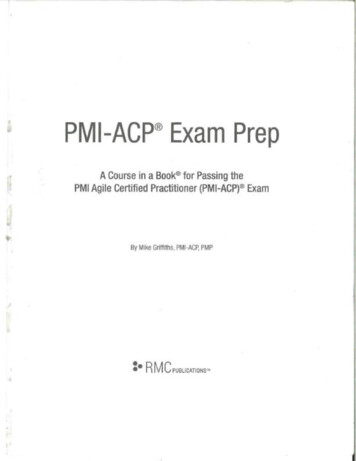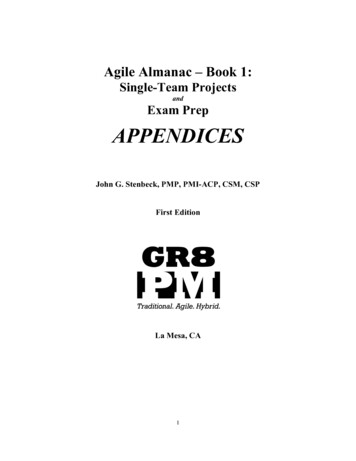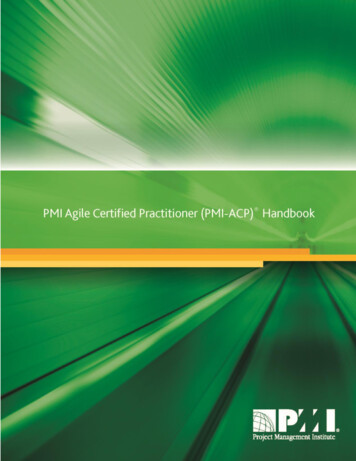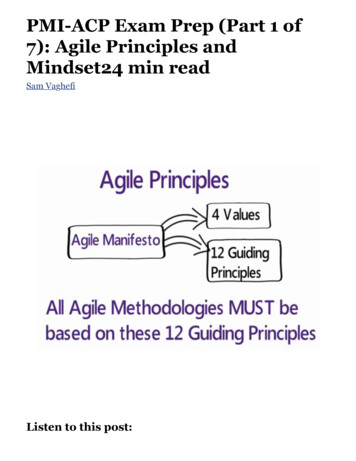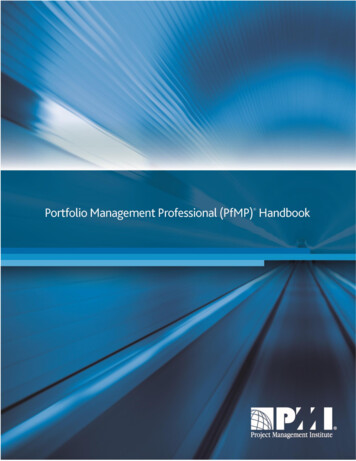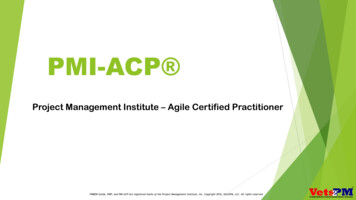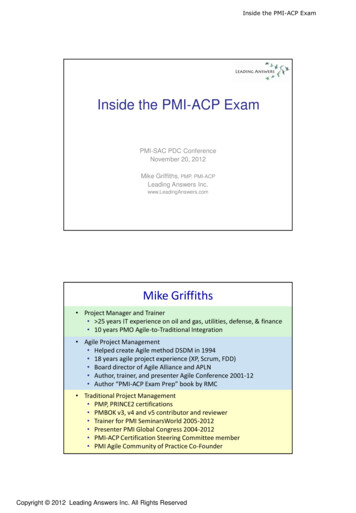
Transcription
Inside the PMI-ACP ExamInside the PMI-ACP ExamPMI-SAC PDC ConferenceNovember 20, 2012Mike Griffiths, PMP, PMI-ACPLeading Answers Inc.www.LeadingAnswers.comMike Griffiths Project Manager and Trainer 25 years IT experience on oil and gas, utilities, defense, & finance 10 years PMO Agile-to-Traditional Integration Agile Project Management Helped create Agile method DSDM in 1994 18 years agile project experience (XP, Scrum, FDD) Board director of Agile Alliance and APLN Author, trainer, and presenter Agile Conference 2001-12 Author “PMI-ACP Exam Prep” book by RMC Traditional Project Management PMP, PRINCE2 certifications PMBOK v3, v4 and v5 contributor and reviewer Trainer for PMI SeminarsWorld 2005-2012 Presenter PMI Global Congress 2004-2012 PMI-ACP Certification Steering Committee member PMI Agile Community of Practice Co-FounderCopyright 2012 Leading Answers Inc. All Rights Reserved
Inside the PMI-ACP ExamPresentation Objectives Explain the PMI and its CertificationsIntroduce the new PMI-ACP CertificationProvide insights into the PMI-ACP ExamExplore the contentLook at some sample materials and questionsProvide some exam taking tipsAgendaCopyright 2012 Leading Answers Inc. All Rights Reserved
Inside the PMI-ACP ExamAs a Product Manager of Credentials at the Project Management Institute (PMI), Ms.Sethuraman is responsible for PMI’s Specialty Certification offerings which include theProject Management Institute Risk Management Professional (PMI-RMP) , ProjectManagement Institute Scheduling Professional (PMI-SP) and PMI’s newestcertification: the PMI-Agile Certified Practitioner (PMI-ACP)SM.Immediately prior to working in the Certification Department with PMI, Priya worked inPMI’s Human Resources department responsible for all domestic and globalEmployment activity as well as providing Human Resources Generalist support to theGlobal Business Units including PMI’s China and India offices. Prior to joining theInstitute, she served as a Director of Human Resources and Organizationaldevelopment to a local non-profit organization.Priya graduated from Temple University with a Bachelor of Arts degree in Psychology,with a specialization in Industrial Organizational Psychology. She also received aMaster’s degree in Organizational Leadership from Cabrini College.About PMI-375,000 members475,000 credential holders13 standards262 chapters38 communities of practice1000’s research papers,case studies, articlesThe Value of Project,Program and PortfolioManagementCopyright 2012 Leading Answers Inc. All Rights Reserved
Inside the PMI-ACP ExamCertificationsPMP Lead and direct project teams to deliver results within theconstraints of budget, time, and scopeCAPM Demonstrates understanding of knowledge, processes, andterminology of the PMBOK Guide PgMP Oversee the success of the program and oversee multipleprojects, advancing strategic and business objectives Define and initiate projects and assign project managersPMI-ACP Understand and apply agile tools, principles and practiceson basic projectsPMI-RMP Assess and identify project risks while mitigating threatsand capitalizing on opportunitiesPMI-SP Develops and maintains and communicates the projectscheduleCertification Holders WorldwideCertification TypePMP CAPM PgMP PMI-ACP PMI-RMP PMI-SP Total CertificationHoldersActive Certification Holders493,91819,4608161,6681,706761As of 9 November 2012Copyright 2012 Leading Answers Inc. All Rights Reserved518,329
Inside the PMI-ACP ExamDemand for AgileGartner (2011):Agile development methods will beutilized in 80% of all softwaredevelopment projects by the end of 2012PMI’s History with AgileCopyright 2012 Leading Answers Inc. All Rights Reserved
Inside the PMI-ACP ExamPMI’s History with Agile Congress presentations since 2004– Dedicated Agile track North America Congress 2011 SeminarsWorld sessions since 2005 Agile Community of Practice established 2009 PMBOK Guide 3rd & 4th edition references to iterativedevelopment Agile reference sources in PMI MarketplacePMI’s Agile Community of Practice Open to all PMI members Has over 14,000 subscribers Explores topics such as the benefits ofimplementing agile techniques, the principles ofagile practices and the variety of agile frameworksand tools Networking within the specialtyCopyright 2012 Leading Answers Inc. All Rights Reserved
Inside the PMI-ACP ExamWhat benefits do subscribers haveaccess to?Community of Practice Subscriber stry NewsWikisBlogsKnowledge Center“Ask theCommunity”Shared DocumentsOVERVIEW OF PMI-ACP Copyright 2012 Leading Answers Inc. All Rights Reserved
Inside the PMI-ACP ExamPMI-ACP Overview Intended for practitioners who work on Agile projectteamso Not just project managers Measures a practitioner’s knowledge and skill inAgile principles, practices, tools, and techniques Covers multiple Agile methodologies Intended to cover use of Agile both in Informationand Communications Technology (ICT) and outsideICTThe Value of PMI-ACP For practitioners, PMI-ACP helps:o Demonstrate a level of professionalism in Agileprinciples, practices, tools and techniqueso Increase professional versatility in projectmanagement For organizations, PMI-ACP demonstrates apractitioner’s:o Knowledge of Agile practices, which shows thepractitioner has greater breadth and depth as aPMCopyright 2012 Leading Answers Inc. All Rights Reserved
Inside the PMI-ACP ExamPMI-ACP – Eligibility RequirementsRequirementDescriptionEducational LevelSecondary degree (high school or equivalent) or higherGeneral ProjectExperience2,000 hours working on project teams. These hours must be earned withinthe last 5 years. Note: a PMP will be accepted to fulfill these requirements.Agile Experience1,500 hours working on Agile project teams. These hours are in addition tothe 2,000 gen. practice hours. These hours must be earned within the last 3years.Agile Training21 contact hours; hours must be earned in Agile project management topicsExaminationTests knowledge of Agile fundamentals and ability to apply to basic projectsMaintenance30 PDUs/3 CEUs every 3 years in Agile project management Note: hourswould count toward PMPCost 435 member; 495 non-memberMarket Reaction Over 12,000 individuals have opened a PMI-ACPapplication, expressing interest Over 550 individuals participated in the PMI-ACPpilot (15 Sept – 30 Nov 2011) Over 3,000 individuals have submitted a PMIACP application As of November 2012, 1,668 PMI-ACP credentialholdersCopyright 2012 Leading Answers Inc. All Rights Reserved
Inside the PMI-ACP ExamCertification ProcessComplete certification applicationSubmit certification application /Initial review of applicationPay certification feeAudit (if selected) of educationand experience documentationTake examination / assessmentsOnce you pass Copyright 2012 Leading Answers Inc. All Rights Reserved
Inside the PMI-ACP ExamCCR Requirements The number of PDUs required varies bycredential: When you have:No. of– PMP/PgMP: 60 PDUsper three yrs– PMP/PMI-RMPor PMI-SP: 60 PDUsper three yrs (30 inspecialty area)AgendaCopyright 2012 Leading Answers Inc. All Rights 060303030
Inside the PMI-ACP ExamAgile, From The PMI?“The PMI is whatagile is rebellingagainst!”“The PMI has noexperience orcredibility in agile!”Research: 65% of PMI members are engaged on IT projects(PMI Membership Survey 2011) 85% of software projects will use Agile approaches(Gartner Research 2011)The PMI Recruits Agile Experts Alistair Cockburn Mike Cottmeyer Jim Cundiff Jesse Fewell,Copyright 2012 Leading Answers Inc. All Rights Reserved Mike Griffiths Ahmed Sidkey Michele Sliger Dennis Stevens
Inside the PMI-ACP ExamExam Design ObjectivesTest Agile project knowledge and application: Most projects Most of the time Some remote team membersNot another Scrum (or XP, FDD) exam Combines Agile, Lean, and KanbanMeet Agile Alliance Exam Guidance“ employers should have confidence only incertifications that are skill-based and difficult toachieve.”AgendaCopyright 2012 Leading Answers Inc. All Rights Reserved
Inside the PMI-ACP ExamExam Content OutlineTools &KnowledgeTechniques& Skills(50%)(50%)Tools & TechniquesThings you should be ableto do. The exam tests yourability to apply them, oftenthrough “do,” “calculate,” or“identify what happensnext” type questionsKnowledge & SkillsThings you should know.The exam tests yourunderstanding and recall ofthem through questions thatassess the “how” and “why”of the topics being testedExam Content OutlineThe “Tools &Techniques”and “Knowledge &Skills”Are split into 6 Domains1) Value Driven Delivery2) Stakeholder Engagement3) Boosting Team Performance4) Adaptive Planning5) Problem Detection & Resolution6) Continuous ImprovementCopyright 2012 Leading Answers Inc. All Rights Reserved
Inside the PMI-ACP ExamExam Content OutlineExam Content OutlineCopyright 2012 Leading Answers Inc. All Rights Reserved
Inside the PMI-ACP ExamExam Content OutlineExam Mark BreakdownCopyright 2012 Leading Answers Inc. All Rights Reserved
Inside the PMI-ACP ExamExam Mark BreakdownRecommended Reading List1. Agile Manifesto and Principles, Various2. Agile Estimating and Planning, by Mike Cohn3. Agile Project Management: Creating Innovative Products, 2nd ed., by JimHighsmith4. Agile Project Management with Scrum, by Ken Schwaber5. Agile Retrospectives: Making Good Teams Great, by Esther Derby and DianaLarsen6. Agile Software Development: The Cooperative Game, 2nd ed., by AlistairCockburn7. Becoming Agile.in an Imperfect World, by Greg Smith and Ahmed Sidky8. Coaching Agile Teams: A Companion for ScrumMasters, Agile Coaches, andProject Managers in Transition, by Lyssa Adkins9. Lean-Agile Software Development: Achieving Enterprise Agility, by AlanShalloway, Guy Beaver, and James R. Trott10. The Software Project Manager’s Bridge to Agility, by Michele Sliger and StaciaBroderick11. The Art of Agile Development, by James Shore and Shane Warden12. User Stories Applied: For Agile Software Development, by Mike CohnCopyright 2012 Leading Answers Inc. All Rights Reserved
Inside the PMI-ACP ExamRecommended Reading ListRecommended Reading ListCopyright 2012 Leading Answers Inc. All Rights Reserved
Inside the PMI-ACP ExamExam Details3 hour computer based multiple choice examoffered at authorized Prometric Test Centres120 multiple choice questions (4 choices, 1 correct answer)(100 scoring questions, 20 test questions)Question TypesQuestions fall into:1. Application of Tools and Techniques2. Recall of Knowledge and Skills3. Situational questionsQ: “An agile team is planning the tools they will use forthe project. They are debating how they should showwhat work is in progress. Of the following options,which tool are they most likely to select?”A) User story backlogB) Product roadmapC) Task boardD) Work breakdown structureCopyright 2012 Leading Answers Inc. All Rights Reserved
Inside the PMI-ACP ExamAgendaA Different PhilosophyPeopleFocusTeam Decision MakingAgileManagementFocusPMBOKProcessFocusCreate WBSRollout Microsoft ProjectServer and Train staffBuild a customerself-service portalFully Defined /Able to DefineUndefined /Hard to DefineProject UncertaintyCopyright 2012 Leading Answers Inc. All Rights Reserved
Inside the PMI-ACP ExamA Different PhilosophyTraditional: Plan what you expect tohappenAgile:Plan what you expect tohappen with detailappropriate to the horizon Enforce that what happensis the same as what isplanned“Control” is through inspectionand adaptation– Directive management– Control, control, control Use change control tomanage change– Reviews and Retrospectives– Self-Organizing TeamsUse Agile practices tomanage change:– Change Control Board– Defect Management– Continuous feedback loops– Iterative and incrementaldevelopment– Prioritized backlogsSample Questions1) The Agile Manifesto value “customer collaboration over contract negotiation” meansthat:A) Agile approaches encourage you not to focus too much on negotiating contracts,since most vendors are just out for themselves anyway.B) Agile approaches focus on what we are trying to build with our vendors, ratherthan debating the details of contract terms.C) Agile approaches prefer not to use contracts, unless absolutely necessary, becausethey hamper our ability to respond to change requests.D) Agile approaches recommend that you only collaborate with vendors who areusing agile processes themselves.Explanation: Valuing customer collaboration over contract negotiation means welook for mutual understanding and agreement, rather than spend our time debatingthe fine details of the agreement.Copyright 2012 Leading Answers Inc. All Rights Reserved
Inside the PMI-ACP ExamSample Questions2) Which of the following items is not a benefit associated with productdemonstrations?A) Learn about feature suitabilityB) Learn about feature usabilityC) Learn about feature estimatesD) Learn about new requirementsExplanation: Product demonstrations provide the benefits of learning about featuresuitability and usability, and they can prompt discussions of new requirements. Theyare not typically used to learn about feature estimates, however, since estimating isdone during estimation sessions, rather than during demonstrations.Sample Questions3) An agile team is planning the tools they will use for the project. They are debatinghow they should show what work is in progress. Of the following options, whichtool are they most likely to select?A) User story backlogB) Product roadmapC) Task boardD) Work breakdown structureExplanation: Of the options presented, the best tool to show work in progress is atask board. The user story backlog shows what work is still remaining to be done onthe project. The product roadmap shows when work is planned to be completed.Work breakdown structures are not commonly used on agile projects.Copyright 2012 Leading Answers Inc. All Rights Reserved
Inside the PMI-ACP ExamTask BoardsKanban BoardsCopyright 2012 Leading Answers Inc. All Rights Reserved
Inside the PMI-ACP ExamSample Questions4) When using a Kanban board to manage work in progress, which of the followingbest summarizes the philosophy behind the approach?A) It is a sign of the work being done and should be maximized to boostperformance.B) It is a sign of the work being done and should be limited to boostperformance.C) It is a sign of the work queued for quality assurance, which should not counttoward velocity.D) It is a sign of the work queued for user acceptance, which should not counttoward velocity.Explanation: A Kanban board shows work in progress (WIP), which represents workstarted but not completed. Therefore, the WIP should be limited and carefullymanaged to maximize performance. More WIP does not equal more output; in fact, itis quite often the opposite.Template for PersonasName (alliteration makes it easier toremember the name)PictureDescriptionValues Things that help us understand thecontext in which the persona willinteract with the system. What value do they want thesystem to give them. Avoid details that have nothing todo with the system. The key is to be able to imagine theperson and “be in their shoes” afterreading the description. What are they looking forwardto getting out of the system. Try to stay away from writingfeatures “what” or the “how” ofthings at this point. Focus more onthe “why.”Copyright 2012 Leading Answers Inc. All Rights Reserved
Inside the PMI-ACP ExamPersonasName: Bob the Movie BuffDescription:Bob loves movies. On average he rents 5movies a week from his local rental store.His two children also like to watch children’sTV shows. Often they like to watch the sameshows more than once, which means thatBob sometimes has to pay late fees.Bob’s wife has different movies tastes to Boband often spends a lot of time choosing amovie.Values:Bob would like to be able to order moviesfrom the comfort of his home. He would liketo be able to search for movies by name,actors, genres and directors. He would alsobe interested in how other viewers rated themovie.He is looking forward to unlimited movies sohis children can watch shows again and againwithout paying additional fees.He would also appreciate a ‘recommended’feature to help him and his wife choosemovies.Sample Questions5) As part of stakeholder management and understanding, the team may undertakecustomer persona modeling. Which of the following would a persona notrepresent in this context?A) Stereotyped usersB) Real peopleC) Archetypal descriptionD) RequirementsExplanation: Personas do represent real, stereotyped, composite, and fictionalpeople. They are archetypal (exemplary) descriptions, grounded in reality, goaloriented, specific, and relevant to generate focus. Personas are not a replacementfor requirements on a project, however.Copyright 2012 Leading Answers Inc. All Rights Reserved
Inside the PMI-ACP ExamSample Questions6) Incremental delivery means that:A) We deliver nonfunctional increments in the iteration retrospectives.B) We release working software only after testing each increment.C) We improve and elaborate our agile process with each increment delivered.D) We deploy functional increments over the course of the project.Explanation: Incremental delivery means that we deploy functional increments overthe course of the project. It does not relate to retrospectives, testing, or changes tothe process, so the other options are incorrect, or “less correct”.Sample Questions7) To ensure the success of our project, in what order should we execute the work,taking into account the necessary dependencies and risk mitigation tasks?A) The order specified by the project management office (PMO)B) The order specified by the business representativesC) The order specified by the project teamD) The order specified by the project architectExplanation: It is largely the business representatives who outline the priority of thefunctional requirements on the project. That prioritization is then a key driver for theorder in which we execute the work.Copyright 2012 Leading Answers Inc. All Rights Reserved
Inside the PMI-ACP ExamSample Questions8) When managing an agile software team, engaging the business in prioritizing thebacklog is an example of:A) Technical risk reductionB) Incorporating stakeholder valuesC) Vendor managementD) Stakeholder story mappingExplanation: We engage the business in prioritizing the backlog to better understandand incorporate stakeholder values. Although such engagement will likely impacttechnical risk reduction, vendor management, or stakeholder story mapping, these arenot the main reasons we engage the business.Not Just Agile - Value Stream Mapping Lean manufacturing technique Illustrates flow, queues Used to determine waste to be removed Focus on value addingCopyright 2012 Leading Answers Inc. All Rights Reserved
Inside the PMI-ACP ExamValue Stream MappingSteps:1. Identify product / service to improve2. Create as-is value stream map3. Identify delays, waste, and constraints4. Create to-be value stream map5. Develop roadmap to optimized state6. Revisit the process in the futureValue Stream MappingExample:Create a Value Stream Map for buying a cake to eat with your friend tocelebrate passing the ACP exam.Step 1 – identify starting point of the process (who initiates it) and the endpoint (who gets the end result)You &Friendeat cakeYouStep 2 - Identify the high level steps, inventories, and queues through theprocessYouCakeSelectionBakerycounterCopyright 2012 Leading Answers Inc. All Rights ReservedPaymentUnpack& sliceYou &Friendeat cake
Inside the PMI-ACP ExamValue Stream MappingStep 3 – Identify any supporting groups and alternative esYou &Friendeat cakeUnpack& sliceValue Stream MappingStep 4 - Measure the value-adding and non-value-adding activities; calculateefficiencies; and identify waste, bottlenecks, and improvement actionsYouValue AddCakeSelection1 MinuteBakerycounterPaymentBakersSales2 Minutes2 MinutesUnpack& sliceYou &Friendeat cake2 Minutes10 MinutesNone Value Add4 Minutes6 Minutes15 Minutes5 MinutesTotal Cycle Time Value Add Time Non Value Add Time Total Cycle Time 47mProcess Cycle efficiency Total Value Add TimeTotal Cycle TimeCopyright 2012 Leading Answers Inc. All Rights ReservedProcess Cycle Efficiency 17m 36%47m
Inside the PMI-ACP ExamValue Stream MappingSteps:1. Identify product / service to improve2. Create as-is value stream map3. Identify delays, waste, and constraints.4. Create to-be value stream map5. Develop roadmap to optimized state6. Revisit the process in the futureValue Stream Mapping7 Forms of WasteWastePartially done workDescriptionWork started, but not complete; partiallydone work can entropyExample Work waiting for QA Requirements waiting fordevelopmentExtra processesExtra work that does not add value Unused documentationUnnecessary approvalsFeatures that are not required, or are thoughtof as nice to haves Gold platingTechnology featuresTask switchingMulti-tasking between several differentprojects that have context-switchingpenalties People on multiple projectsWaitingDelays waiting for reviews and approvals Waiting for prototype reviewsWaiting for document approvalsExtra features MotionDefectsThe effort required to communicate or moveinformation or deliverables from one group toanother; if teams are not co-located, thiseffort may need to be greater Defective documents or work products thatneeds correction Copyright 2012 Leading Answers Inc. All Rights Reserved Distributed teamsHandoffsRequirement defectsImpractical processes
Inside the PMI-ACP ExamValue Stream MappingCreate To-Be Value Stream Map – Without the waste( Phone the “Cake Caterer” and place an order for delivery )( Removes Waiting and Travel time wastes )YouValue AddCall akerOrderTaker2 Minutes1 MinuteYou &Friendeat cakeUnpack& slice2 Minutes2 Minutes10 MinutesNone Value Add2 MinutesTotal Cycle Time Value Add Non value Add time10 Minutes1 Minute5 MinutesTotal Cycle Time 35mProcess Cycle efficiency Total Value Add TimeTotal Cycle TimeProcess Cycle Efficiency 17m 49%35mSample Questions9) The steps involved in value stream analysis include:A) Create a value stream map to document delays and wasted time, such asmeetings and coffee breaks.B) Create a value stream map of the current process, identifying steps, queues,delays, and information flows.C) Review the value stream map of the current process and compare it to thegoals set forth in the project charter.D) Review how to adjust the value stream charter to be more flexible.Explanation: The only option here that is a step in value stream analysis is “Createa value stream map of the current process, identifying steps, queues, delays, andinformation flows.” None of the other options are valid steps in value streammapping.Copyright 2012 Leading Answers Inc. All Rights Reserved
Inside the PMI-ACP ExamSample Questions10) What is the process cycle efficiency of a 2-hour meeting if it took you 2 minutesto schedule the meeting in the online calendar tool and 8 minutes to write theagenda and e-mail it to participants?A) 90%B) 8%C) 92%D) 96%Explanation: The formula for finding process cycle efficiency is: Total value-addedtime / total cycle time. In this question, the value-added time is 2 hours, and the totalcycle time is 2 minutes 8 minutes 120 minutes 130 minutes. So the correctanswer is 120 / 130 92%.AgendaCopyright 2012 Leading Answers Inc. All Rights Reserved
Inside the PMI-ACP ExamPMI ACPism’sBe aware of Exam Question Assumptions: Assume a small, dedicated team (7 plus or minus 2) rather than a large one Delivery Team includes scrum master BA, QA, developer, product owner Collaboration is always better than command control style management Face-to-face (co-location) is better than virtual A stable team establishes a predictable velocity Teams self-organize, self-govern, self-directed, make their own commitments Recognize you can’t know everything at the beginning of a project A software product can be delivered incrementally Questions are asked from the perspective of a team On the iron triangle, agile sets the time and cost, scope varies Terminology: Timebox, sprint (scrum), iteration (xp) are used interchangeablyExam Taking Tips 11. Find the test centre ahead of time2. Bring authorization letter & two forms of ID3. Wear comfortable clothes4. Bring snacks5. You will be given scratch paper and pencils6. Write down anything you are having trouble remembering7. You will see one question on the screen at a time. You can answer aquestion and/or mark it to return to it later.8. The exam does not adapt to your answers9. Use deep-breathing techniques to help relax10. Use all the exam time. Do not leave early unless you have reviewedeach question twice.Copyright 2012 Leading Answers Inc. All Rights Reserved
Inside the PMI-ACP ExamExam Taking Tips 211. Find the question in the question text then read the rest of the text.Determine what your answer should be, and then look at the answeroptions shown12. Read all 4 choices and choose the BEST answer13. Quickly eliminate answers that are highly implausible14. There may be more than one “correct” answer to each question, butonly one “BEST” answer15. Watch out for choices that are true statements, but do not answerthe question16. Options that represent broad, sweeping generalizations tend to beincorrect, so be alert for “always,” “never,” “must,” “completely,” andso forth. Alternatively, choices that represent carefully qualifiedstatements tend to be correct, so be alert for words such as “often,”“sometimes,” “perhaps,” “may,” and “generally.”Additional ResourcesOnline Resources: PMI tification.aspx Leading Answers Blog www.LeadingAnswers.com Email: Mike@LeadingAnswers.comCopyright 2012 Leading Answers Inc. All Rights Reserved
Author “PMI-AP Exam Prep” book by RM Traditional Project Management PMP, PRINCE2 certifications . As a Product Manager of Credentials at the Project Management Institute (PMI), Ms. . Inside the PMI-ACP Exam 4) When using a Kanban boa
